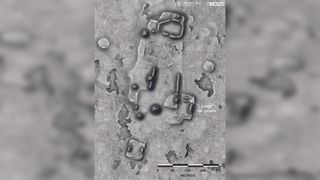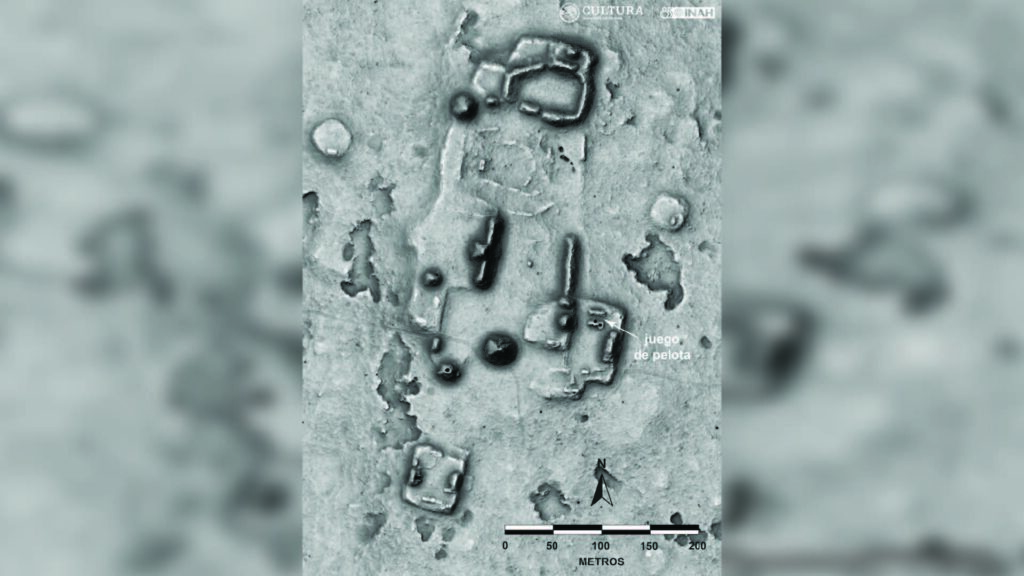
A lidar-created image showing the site with the ball court where parts of an underground structure were found.
(Image credit: Visualization of the Žiga Koka LiDAR data)
Archaeologists in Mexico have discovered a mysterious subterranean structure with painted walls hidden beneath a Maya ball court.
The team found the building while excavating the ball court, the playing space for the ritual ball game played by the Maya and other Mesoamerican peoples.
“We located parts of an earlier building that had painted walls, but only further excavations may reveal the shape of that underlying building and what its function was,” said Ivan Šprajc, an archaeologist at the Institute of Anthropological and Spatial Studies in Slovenia and director of the excavation.
The finding is “evidently a very important structure, because ball courts are normally found only at major Maya sites, which were centers of the regional political organization,” Šprajc told Live Science in an email. The structure could date to the Early Classic period (A.D. 200 to 600) and is covered with a layer of painted stucco, according to a translated statement from Mexico’s National Institute of Anthropology and History.
Previously, Šprajc and his colleagues surveyed a large area of the Maya Lowlands in the Mexican state of Campeche with lidar, a technique that shoots millions of laser pulses from an aircraft. These pulses then bounce off the ground and return to the machine in the aircraft, allowing researchers to map the landscape’s topography.
“We have found several ancient Maya settlements, with remains of residential buildings and temple pyramids,” Šprajc said. In 2023, the team found Ocomtún, a lost Maya city that has several large pyramids from the Maya Classic period (circa A.D. 200 to 900). The newfound site is in a previously unexplored area south of Ocomtún, he said.
In addition, the team discovered another site that includes a plaza, a 52-foot-high (16 meters) pyramid and a rectangular water reservoir, according to the statement. On top of the pyramid, the archaeologists found some offerings: ceramic vessels; a ceramic animal leg, possibly of an armadillo; and a chert knife or spear point.
Get the world’s most fascinating discoveries delivered straight to your inbox.
These offerings “were deposited on top of the temple in the Late Postclassic period (last centuries before the arrival of Spanish conquerors),” from 1250 to 1524, Šprajc said.
By the Late Postclassic, the central Maya Lowlands had already fallen into political disarray. But people “remained in the area after the crisis that led to the drastic demographic decrease in the 9th and 10th centuries, caused by overpopulation, soil depletion, climatic change (prolonged droughts) and destructive warfare,” he said.
“The offering indicates that, even after most of the Classic period Maya settlements had been abandoned, small and impoverished human group[s] were still rambling around, putting offerings on or near the buildings of their forebears,” Šprajc said.
Laura is the archaeology and Life’s Little Mysteries editor at Live Science. She also reports on general science, including paleontology. Her work has appeared in The New York Times, Scholastic, Popular Science and Spectrum, a site on autism research. She has won multiple awards from the Society of Professional Journalists and the Washington Newspaper Publishers Association for her reporting at a weekly newspaper near Seattle. Laura holds a bachelor’s degree in English literature and psychology from Washington University in St. Louis and a master’s degree in science writing from NYU.
>>> Read full article>>>
Copyright for syndicated content belongs to the linked Source : Live Science – https://www.livescience.com/archaeology/mysterious-maya-underground-structure-unearthed-in-mexico
